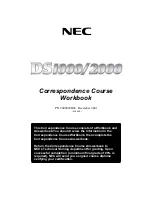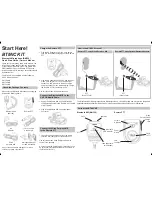
Leuchtet sie nicht, überprüfen, ob:
a der Sender auf den gleichen Kanal eingestellt
ist wie der Empfänger.
b die Batterien des Senders verbraucht sind.
c der Abstand zwischen dem Sender und dem
Empfänger zu groß ist.
d der Empfang durch Gegenstände in der Über-
tragungsstrecke gestört ist; der Sender und
der Empfänger sollten einen Mindestabstand
von 50 cm zu Metallgegenständen und mögli-
chen Störquellen, wie z. B. Elektromotoren
oder Leuchtstoffröhren, haben.
e sich der Empfang durch Schwenken der Emp-
fangsantennen verbessern lässt.
f
die Rauschsperre mit dem Regler SQUELCH
(8) zu hoch eingestellt ist
→
siehe Punkt 7.
5) Das nachfolgende Audiogerät einschalten bzw.
den entsprechenden Mischpultregler aufziehen.
6) In das Mikrofon sprechen/singen und mit dem
Lautstärkeregler VOLUME (2) den Ausgangspe-
gel des Empfängers an den Eingang des nach-
folgenden Geräts anpassen. Wird der Empfänger
durch eine zu hohe Lautstärke am Mikrofon über-
steuert, leuchtet die Anzeige AF PEAK (4) auf
(unabhängig von der Einstellung des Reglers
VOLUME).
Bei dem Taschensender
2
lässt sich die Emp-
findlichkeit für das angeschlossene Mikrofon über
den Regler MT (19) einstellen und so der Laut-
stärkepegel des Mikrofons korrigieren: Ist das
Mikrofonsignal zu laut und dadurch verzerrt, den
Regler mit dem Einstellschlüssel (22) entspre-
chend zurückdrehen; bei zu geringem Pegel er-
gibt sich dagegen ein schlechter Rauschabstand,
den Regler dann entsprechend aufdrehen.
7) Mit dem Regler SQUELCH (8) den Schwellwert
einstellen, bei dem die Störunterdrückung anspre-
chen soll. Je weiter der Regler im Uhrzeigersinn
aufgedreht wird, desto höher liegt der Schwell-
wert. Zum Drehen kann der Einstellschlüssel (16)
bzw. (22) des Senders verwendet werden.
Die Störunterdrückung sorgt für eine Stumm-
schaltung des Empfängers, wenn in Musikpausen
hochfrequente Störsignale empfangen werden,
deren Pegel unter dem eingestellten Schwellwert
liegen. Mit höherem Schwellwert reduziert sich
allerdings auch die Reichweite des Funksystems,
da der Empfänger auch stumm geschaltet wird,
wenn die Funksignalstärke des Senders unter
den eingestellten Schwellwert absinkt. So kann
bei gutem Empfang des Mikrofonsignals mit dem
Regler SQUELCH ein höherer Schwellwert ein-
gestellt werden, bei größerer Entfernung zwi-
schen Sender und Empfänger dagegen sollte ein
niedrigerer Wert gewählt werden.
8) Nach dem Betrieb den Empfänger und den Sen-
der ausschalten:
– am Empfänger die Taste POWER wieder aus-
rasten, die Betriebsanzeige ON erlischt.
– am Sender den Schiebeschalter auf „OFF“
stellen. Die Anzeige BATT. leuchtet kurz rot auf.
Wird das Mikrofonsystem längere Zeit nicht ge-
nutzt, das Steckernetzgerät des Empfängers aus
der Steckdose ziehen, da es trotz ausgeschalte-
tem Empfänger einen geringen Strom ver-
braucht.
7
Technische Daten
Systemtyp: . . . . . . . . . PLL-Multifrequenz-System
Empfangstechnik: . . . . Diversity
Funkfrequenzbereich: 790,125 – 813,125 MHz,
16 Kanäle
→
siehe Kap. 5.4
Sendeleistung: . . . . . . < 10 mW (EIRP)
Reichweite: . . . . . . . . . ca. 30 m
HF-Rauschabstand: . . > 90 dB
Typ Handmikrofon
1
: . . dynamisch, Nierencharakt.
Audiofrequenzbereich: 50 – 15 000 Hz, ±3 dB
Klirrfaktor: . . . . . . . . . . < 1 %
Dynamik: . . . . . . . . . . > 100 dB
Audioausgänge
XLR: . . . . . . . . . . . . 100 mV/10 k
Ω
, sym.
6,3-mm-Klinke: . . . . 50 mV/10 k
Ω
, asym.
Einsatztemperatur: . . . 0 – 40 °C
Stromversorgung
Empfänger: . . . . . . . 12 – 18 V
/0,3 A über das
beiliegende Netzgerät
(230 V~/50 Hz/5 VA)
Sender: . . . . . . . . . . zwei 1,5-V-Batterien
(oder zwei 1,2-V-Akkus)
der Größe Mignon/AA
Maße, Gewicht
Empfänger: . . . . . . . 200
×
45
×
130 mm, 370 g
Handmikrofon
1
: . . . Ø 48 mm
×
235 mm, 165 g
Taschensender
2
: . . 65
×
110
×
30 mm, 105 g
Änderungen vorbehalten.
If it does not light up, check if:
a the transmitter has been set to the same
channel as the receiver.
b the batteries of the transmitter are exhausted.
c the distance between the transmitter and the
receiver is too long.
d the reception is disturbed by objects in the
transmission path; the transmitter and the re-
ceiver should have a minimum distance of
50 cm to metal objects and possible sources of
interference, e. g. motors or fluorescent tubes.
e the reception can be improved by moving the
receiving antennas.
f
the noise squelch has been adjusted too high
with the control SQUELCH (8)
→
see item 7.
5) Switch on the following audio unit or advance the
corresponding mixer control.
6) Speak/sing into the microphone and match the
output level of the receiver to the input of the fol-
lowing unit with the control VOLUME (2). If the
receiver is overloaded by a volume on the micro-
phone which is too high, the LED AF PEAK (4)
lights up (independent of the adjustment of the
control VOLUME).
On the pocket transmitter
2
, the sensitivity for
the connected microphone can be adjusted via
the control MT (19) and thus the volume level of
the microphone readjusted: If the microphone
signal is too high and thus distorted, turn back the
control with the adjusting key (22) accordingly;
however, if the level is too low, a poor noise ratio
occurs, then turn up the control accordingly.
7) With the control SQUELCH (8) adjust the threshold
value at which the interference suppression should
respond. The further the control is turned up clock-
wise, the higher the threshold value. For turning,
use the adjusting key (16) or (22) of the transmitter.
The interference suppression provides a mut-
ing of the receiver if during music breaks interfer-
ing signals of high frequencies are received
whose level is below the adjusted threshold value.
However, with a higher threshold value also the
range of the wireless system is reduced, as the
receiver is also muted when the power of the radio
signal of the transmitter falls below the adjusted
threshold value. Thus, with a good reception of
the microphone signal a higher threshold value
can be adjusted with the control SQUELCH.
With a longer distance between transmitter and
receiver, however, a lower value should be se-
lected.
8) After operation switch off the receiver and the
transmitter:
– unlock the button POWER on the receiver, the
operating indication ON is extinguished.
– on the transmitter, adjust the sliding switch to
“OFF”. The indication BATT. shortly shows
red.
If the microphone system is not used for a longer
time, disconnect the power supply unit of the
receiver from the socket, as it consumes a low
current even if the receiver is switched off.
7
Specifications
System type: . . . . . . . PLL multifrequency system
Receiving technique: . diversity
Radio frequency range: 790.125 – 813.125 MHz,
16 channels
→
see chap. 5.4
Transmission power: . < 10 mW (EIRP)
Range: . . . . . . . . . . . . approx. 30 m
HF noise ratio: . . . . . . > 90 dB
Type of hand-held
microphone
1
: . . . . . . . dynamic, cardioid
Audio frequency range: 50 – 15 000 Hz, ±3 dB
THD: . . . . . . . . . . . . . . < 1 %
Dynamic power: . . . . . > 100 dB
Audio outputs
XLR: . . . . . . . . . . . . 100 mV/10 k
Ω
, bal.
6.3 mm jack: . . . . . . 50 mV/10 k
Ω
, unbal.
Ambient temperature: . 0 – 40 °C
Power supply
Receiver: . . . . . . . . 12 – 18 V
/0.3 A via the
supplied power supply unit
(230 V~/50 Hz/5 VA)
Transmitter: . . . . . . two 1.5 V batteries
(or two 1.2 V rechargeable
batteries) of type AA
Dimensions, weight
Receiver: . . . . . . . . 200
×
45
×
130 mm, 370 g
Hand-held
microphone
1
: . . . . . Ø 48 mm
×
235 mm, 165 g
Pocket transmitter
2
: 65
×
110
×
30 mm, 105 g
Subject to technical modifications.
7
GB
D
A
CH
Diese Bedienungsanleitung ist urheberrechtlich für
MONACOR
®
INTERNATIONAL GmbH & Co. KG ge-
schützt. Eine Reproduktion für eigene kommerzielle
Zwecke – auch auszugsweise – ist untersagt.
1. nur bei TXS-810SET
2. nur bei TXS-830SET
1. only for TXS-810SET
2. only for TXS-830SET
All rights reserved by MONACOR
®
INTERNATIONAL
GmbH & Co. KG. No part of this instruction manual may
be reproduced in any form or by any means for any
commercial use.






























